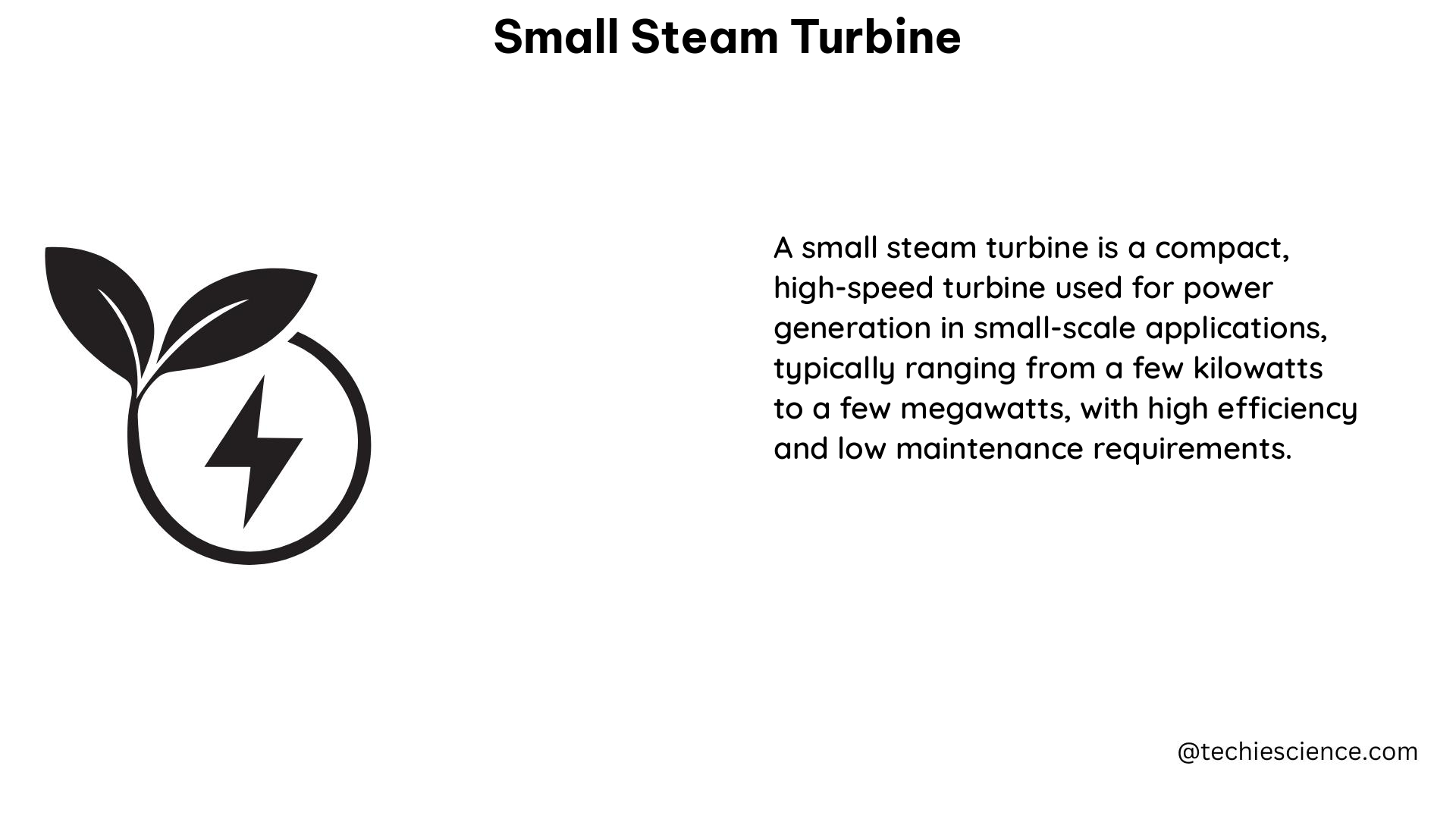Small steam turbines, also known as miniature or micro steam turbines, are compact and versatile power generation systems designed to meet the growing demand for distributed and decentralized energy solutions. These turbines offer a range of advantages, including high efficiency, low maintenance, and the ability to operate on a variety of fuel sources, making them an increasingly popular choice for a wide array of applications.
Size and Weight Specifications
Small steam turbines can vary significantly in size, ranging from as small as a few inches in diameter to as large as a few feet. The weight of these turbines can also vary greatly, from a few pounds to several hundred pounds, depending on the specific design and materials used in their construction.
For example, the Dresser-Rand DATUM series of small steam turbines, which are designed for power generation and mechanical drive applications, can range in size from 6 inches to 36 inches in diameter and weigh between 100 and 3,000 pounds, depending on the model.
Power Output and Efficiency

The power output of small steam turbines can also vary widely, typically ranging from a few kilowatts to a few hundred kilowatts. The efficiency of these turbines is largely dependent on their design and size, with smaller turbines generally having lower efficiencies compared to their larger counterparts.
According to a study published in the Journal of Engineering for Gas Turbines and Power, small steam turbines with power outputs ranging from 10 to 100 kW can have efficiencies ranging from 15% to 30%. However, advancements in design and materials have led to the development of small steam turbines with efficiencies as high as 35% or more.
Rotational Speed and Operating Conditions
The rotational speed of small steam turbines can also vary significantly, ranging from a few hundred revolutions per minute (RPM) to several thousand RPM. This is largely dependent on the specific design and application of the turbine.
In terms of operating conditions, small steam turbines can be designed to operate with a wide range of steam pressures and temperatures. For example, the Dresser-Rand DATUM series of turbines can operate with steam pressures ranging from 50 to 1,500 psig and steam temperatures ranging from 400°F to 1,000°F.
Materials of Construction
The materials used in the construction of small steam turbines can also vary, depending on the specific operating conditions and design requirements. Common materials used include stainless steel, titanium, and Inconel, each with their own unique properties and advantages.
For example, stainless steel is a popular choice for its corrosion resistance and durability, while titanium is often used for its high strength-to-weight ratio and resistance to high temperatures. Inconel, on the other hand, is a nickel-based alloy that is known for its exceptional resistance to corrosion and high-temperature environments.
Cost Considerations
The cost of small steam turbines can also vary significantly, ranging from a few thousand dollars to several hundred thousand dollars, depending on the size, design, and materials of construction. Factors such as the complexity of the turbine, the level of customization required, and the specific application can all impact the overall cost.
It’s important to note that the cost of a small steam turbine is not the only factor to consider when evaluating its suitability for a particular application. Other factors, such as the turbine’s efficiency, reliability, and maintenance requirements, should also be taken into account to ensure that the investment provides the best long-term value.
Alignment and Measurement Considerations
In addition to the physical specifications and operating parameters of small steam turbines, it’s also important to consider the technical requirements related to alignment, straightness, and measurement. Proper alignment and measurement are critical to ensuring the efficient and reliable operation of these turbines.
One tool that can be used to measure and adjust the alignment of small steam turbines is the Easy-Laser E960 Turbine Alignment system. This system can be used to measure and adjust diaphragms and bearings in small steam turbines, with a measuring probe that has a stroke of 10 mm or 60 mm, depending on the size of the turbine. The system can measure objects up to 40 m (132 feet) away, with a detector that reads measurement values with a resolution of 0.001 mm (0.05 mils).
Conclusion
Small steam turbines are a versatile and efficient power generation solution that are becoming increasingly popular in a wide range of applications. By understanding the key specifications and technical requirements of these turbines, engineers and technicians can design, install, and maintain these systems to maximize their performance and reliability.
Whether you’re working on a small-scale power generation project or a larger industrial application, this comprehensive guide to small steam turbines can provide you with the information and insights you need to make informed decisions and achieve your energy goals.
References:
- Easy-Laser. (n.d.). E960 – Turbine alignment, geometric measurement. Retrieved from https://easylaser.com/en-us/products/geometric-measurement/e960-turbine-alignment
- Ohio Northern University. (2002). Steam Turbine Experiment. Retrieved from https://www.turbinetechnologies.com/Portals/0/pdfs/RankineCycler_tech_sheets/Ohio-Northern-University-Lab50A14.pdf
- Jianxi, Y., Wenquan, H., Kang, L., Pei, L., & Zheng, L. (2022). Gross error detection in steam turbine measurements based on data reconciliation of inequality constraints. Computers & Industrial Engineering, 156, 107711.
- Dresser-Rand. (n.d.). DATUM Series Steam Turbines. Retrieved from https://www.dresser-rand.com/products/steam-turbines/datum-series-steam-turbines/
- Baines, N. C. (2003). Axial and radial turbines. In Fluid Mechanics and Thermodynamics of Turbomachinery (pp. 231-292). Butterworth-Heinemann.
- Moustapha, H., Zelesky, M. F., Baines, N. C., & Japikse, D. (2003). Axial and radial turbines. Concepts NREC.

The lambdageeks.com Core SME Team is a group of experienced subject matter experts from diverse scientific and technical fields including Physics, Chemistry, Technology,Electronics & Electrical Engineering, Automotive, Mechanical Engineering. Our team collaborates to create high-quality, well-researched articles on a wide range of science and technology topics for the lambdageeks.com website.
All Our Senior SME are having more than 7 Years of experience in the respective fields . They are either Working Industry Professionals or assocaited With different Universities. Refer Our Authors Page to get to know About our Core SMEs.